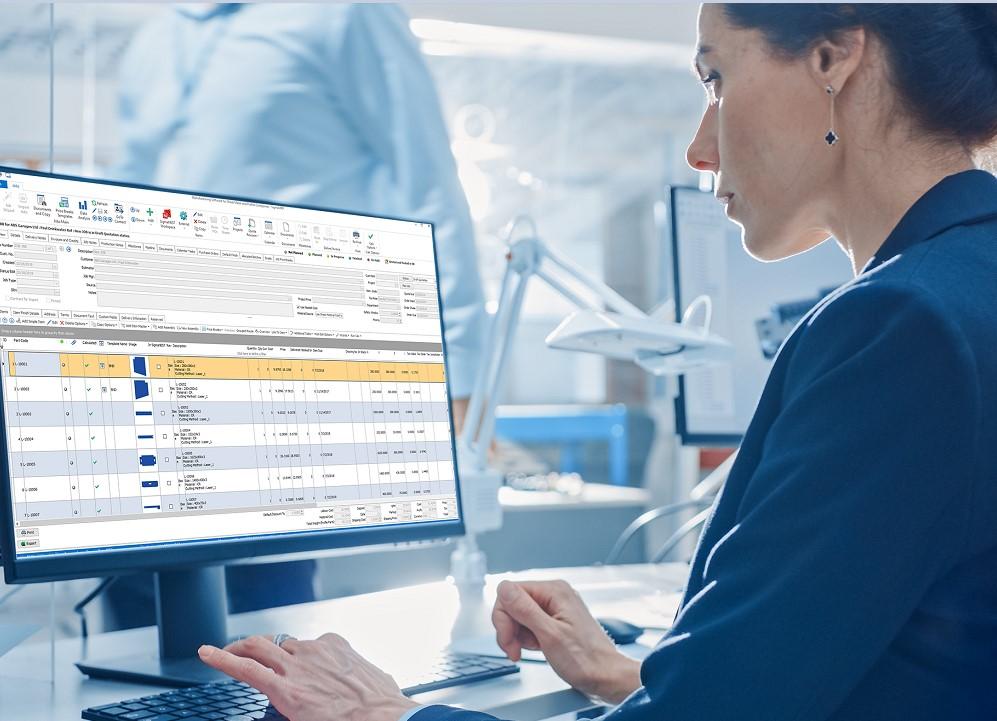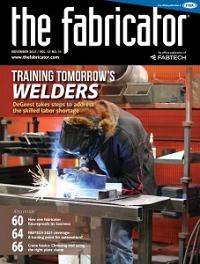Product Owner-Business Systems
- FMA
- The Fabricator
- FABTECH
- Canadian Metalworking
Categories
- Additive Manufacturing
- Aluminum Welding
- Arc Welding
- Assembly and Joining
- Automation and Robotics
- Bending and Forming
- Consumables
- Cutting and Weld Prep
- Electric Vehicles
- En Español
- Finishing
- Hydroforming
- Laser Cutting
- Laser Welding
- Machining
- Manufacturing Software
- Materials Handling
- Metals/Materials
- Oxyfuel Cutting
- Plasma Cutting
- Power Tools
- Punching and Other Holemaking
- Roll Forming
- Safety
- Sawing
- Shearing
- Shop Management
- Testing and Measuring
- Tube and Pipe Fabrication
- Tube and Pipe Production
- Waterjet Cutting
Industry Directory
Webcasts
Podcasts
FAB 40
Advertise
Subscribe
Account Login
Search
10 features of a good quoting system
How metal fab shops can win contracts, standardize quoting practices with latest software options
- By Wayne Cathers
- Updated November 30, 2021
- November 29, 2021
- Article
- Shop Management

A good quoting system relies on a nesting engine, part database, and costing parameters to deliver accurate quotes after a speedy import of part geometry. Images provided
Editor's note: This feature originally appeared in the August 2021 issue of Canadian Fabricating & Welding.
With all the latest and greatest software enhancements, quoting modules and systems can make it easier for shops to win contracts and expand their profit margin. When looking to implement a quoting module, shops should explore and consider a number of factors and features to ensure they are getting the right system for their manufacturing needs.
Expandable Options
With quoting software, one of the main features is its ability to calculate quotes. Whether it’s for a small job shop or a large corporation, different options are available to increase a fabricator’s bottom line. However, these modules are particularly suited for shops that do a significant amount of quoting.
Some OEMs that produce their own products may not need to quote every day. That’s not to say that the quoting modules won’t be helpful, but they may be used in conjunction with additional expansion modules for a more complete system and comprehensive view of the shop floor.
To choose the right quoting module, fabricators need to think of the future. They shouldn’t limit themselves to choosing just a stand-alone option if there are expected areas of growth where an expanded package would make more sense.
Accuracy Is Important
An inaccurate quote can cost fabricators their hard-earned dollars. Choosing a module that offers fast, accurate quotes is essential.
With sheet metal prices as high as they are, getting the most accurate quote and making sure that the software accounts for every bit of cost associated with the project can make all the difference. The last thing any fabricator wants is to underquote a project. The operation costs, whether its cutting, bending, or welding, need to be considered for accurate calculations. A software option that takes many of these factors into account will help fabricators provide detailed and correct quotes.
Win Quotes With Speed
Fabricators don’t have to spend an hour preparing manual quotes. With a fast and advanced quoting module, they can take parts or drawings from customers and make a quote in as little as five minutes. The best part is that they often can send it to their customer before they walk away from their computer.
Data demonstrates that the quicker a shop can get a quote to its customer, the more likely it is to win the quote.
CAD/CAM Integration
Direct integration with a CAD/CAM package can be a huge benefit for any fabricator. Using an integrated quoting module adds a lot of functionality, including enhanced drawing features.

FIGURE 2. A flexible quoting system allows jobs to be scheduled at the time of the quote, modified after job creation, and then pushed directly into a production work order.
Not all drawings are clean, and some can even be pictures of drawings on napkins or PDFs. Having integration provides tools to allow fabricators to clean up drawings and automatically adjust geometry. A filter feature, which can come with the quoting package, can be used to clean up tiny gaps, splines, or jagged geometry.
Not all quoting software is integrated with CAD/CAM, and this might be an important feature for some shops that have that additional need to adjust drawings for more accurate quoting.
Production Quoting
Integration with CAD/CAM also allows for some advanced quoting features that consider production costs.
Production quoting provides fabricators with a more comprehensive picture for more accurate quoting. This type of quoting is based on how parts are going to be nested or could be nested for manufacturing. It also takes into account the actual machine costs as well as all of the other operations.
The nested cost is especially important for accurate quotes. With many parts, it’s good to know how many sheets it would take to complete the project. Also, if there are many different parts or a big, long L-shaped part, it may include a lot of scrap material that can’t be salvaged. That needs to be worked into the cost as well.
Most fabricators are already set up with different scripts or equations that they use to calculate how much time it takes to do a certain operation. All the CNC cutting data is set up in advance. For a quote, the user just adds in the parts needed and which operations are needed, and all the math happens in the background.
Move Straight to Production
Fabricators should look for quoting packages that can seamlessly move straight from the quote to production. If the quoting module is integrated with CAD/CAM and through an MRP/MES system, once a fabricator wins a quote, it can go into the software and easily change the status from quote to order with the click of a drop-down menu. Everything is taken care of automatically and it's ready for production.
Scheduling Jobs
Some of the latest technology includes the ability for scheduling. This feature can schedule all the operations for the entire shop floor. With this, fabricators can actually preschedule the job before they accept the order. That way, if a customer accepts the quote and wants to know how soon they can expect the project, all the information is available.
For shops that often take on rush jobs, this can be a huge benefit.
Wide-ranging File Formats
Choosing a quoting package that can import any file type is another plus. The last thing any shop wants to do is go back to a customer and tell them they cannot open the file and are unable to quote the project.
Today there are so many different file formats that shops are expected to handle. They might get 20 different files formats from 20 different customers, and whether it’s DXF, SolidWorks, Inventor, or any number of different free design program files, importing them should not be an issue.
Access to More Info
Fabricators should look for a quoting module that is database-driven, showing things like customer information, due dates, and all necessary line items. It should also be highly customizable so that fabricators can easily make adjustments.
For example, if a shop wants to give a customer a price break or discount, or if bulk pricing is needed, all that can be applied in the module. If a shop expects to do some negotiations and change the quoted price, the quoting package should have the ability to override the price and recalculate with the specific parameters dialed in.
A fabricator should also be able to perform revisions of the quote. Let’s say a customer comes back and asks for parts to be left out of the project or added in. That information can be entered into the software, which allows for traceability and proper accounting.
Database-driven systems can offer all sorts of tools to help with a shop’s day-to-day accounting, such as built-in tools like reports and graphics. A fabricator should be able to access information about all the quotes won and those that have been lost. Such systems can also produce reports on how much profit a shop makes in a customized date range and determine how much a job costs versus how much the average markup is. This information can help shops quote future projects better and see historical trends in pricing and profit margins. All of that data should be readily available for shops to pull various data points at any time.
Standardize Quoting
A quoting system can benefit shops in many ways, but its features are really designed to standardize quoting. High-quality software should help a shop standardize operations across the board. Adding different features and modules will make this system even more powerful.
Without a quoting module, shops often have one or two people whose jobs are dedicated to quoting projects. This may work for some fabricators, but it can also be problematic for a number of reasons. Every worker may have their own way of quoting, looking at different metrics and parameters to calculate costs. This can lead to discrepancies and quoting fluctuations and no historically standardized way to track how quotes were handled. There also could be variance with the way the person quotes job to job.
If multiple people are quoting projects, they could all quote the same job in different ways with different pricing and markups. This can lead to pricing errors and make it very hard to predict costs and project profit margin.
Another concern is that if a shop has only one estimator, and that employee leaves, then a shop is left to train a new person to quote jobs. Inexperienced quoters may make calculation mistakes, leading to margin issues or costing errors. There may also be a period of time when quoting is both slow and inaccurate while the person is still learning the process, if there even is one in place.
With a quoting module, all this is automated and standardized. The calculations, costs, markups, production metrics, and all available data are applied and used for the system to properly quote a project. With it, fabricators can get the same quote every time based on the same metrics and workflow, no matter who is using the software. It gives shops that sense of stability that is so important for best business practices.
About the Author
Wayne Cathers
1445 Kemper Meadow Dr.
Cincinnati, OH 45240-1637
513-674-0005
Related Companies
subscribe now

The Fabricator is North America's leading magazine for the metal forming and fabricating industry. The magazine delivers the news, technical articles, and case histories that enable fabricators to do their jobs more efficiently. The Fabricator has served the industry since 1970.
start your free subscription- Stay connected from anywhere

Easily access valuable industry resources now with full access to the digital edition of The Fabricator.

Easily access valuable industry resources now with full access to the digital edition of The Welder.

Easily access valuable industry resources now with full access to the digital edition of The Tube and Pipe Journal.
- Podcasting
- Podcast:
- The Fabricator Podcast
- Published:
- 04/16/2024
- Running Time:
- 63:29
In this episode of The Fabricator Podcast, Caleb Chamberlain, co-founder and CEO of OSH Cut, discusses his company’s...
- Industry Events
16th Annual Safety Conference
- April 30 - May 1, 2024
- Elgin,
Pipe and Tube Conference
- May 21 - 22, 2024
- Omaha, NE
World-Class Roll Forming Workshop
- June 5 - 6, 2024
- Louisville, KY
Advanced Laser Application Workshop
- June 25 - 27, 2024
- Novi, MI































